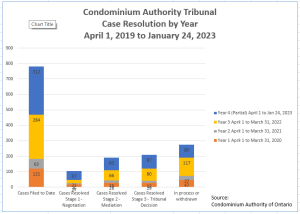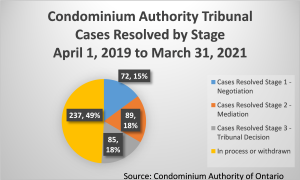 March 2023
March 2023
The Condominium Authority of Ontario (CAO) is celebrating its fifth year of operation. In this five-part series, Toronto Condo News looks at how CAO and the Condominium Authority Tribunal have impacted on condominium living and management, and present an inside-view of what it is like to appear before the Tribunal.
February 2022 – Fairness and Justice in Condominium Communities
March 2022 – What they Don’t Want you to Know – Lurking behind their closed door
April 2022 – Making a Successful CAT Submission
May 2022 – Calling for the Expansion of CAT
June 2022 – Condo Disputes without CAT
Just how well has the Tribunal functioned? How many submissions have they been hearing and how are they getting resolved? What we really want to know is if the Tribunal is doing good work and being effective.
In Effectiveness of the Condominium Authority Tribunal, Toronto Condo News provided an overview of Condominium Authority Tribunal (CAT or Tribunal) operations utilizing public data provided by the Condominium Authority of Ontario (CAO). Making a Successful CAT Submission (April 2023) will provide a behind-the-scene look at how to succeed before the Tribunal including tips and suggestions obtained by following one submission through all three stages of the Tribunal.

In its first year of operation, CAT received 121 submissions. Nearly 40 percent of submissions continued into the next year or were withdrawn. This represents a little more than two submissions weekly. During its second year of operation, these numbers drop by about 50 percent. More recently, there has been an increase in the number of submissions. They are getting resolved more efficiently with fewer being withdrawn or carried forward to the next fiscal year.
The Landlord and Tenant Board (LTB), which deals with landlord and tenant conflicts, received approximately 80,000 applications per year – more than 1,500 per week – in the two years preceding Covid. This dropped to about 48,000 applications because of the five-month Covid-induced closure. In British Columbia, the Civil Resolution Tribunal (CRT) is an online tribunal that handles over 5,000 submissions annually – between 120 and 140 weekly.

In light of these comparisons, the CAT hearing fewer than five submissions weekly in a region that includes a city the size of Toronto could mean that condominium living is a nearly idyllic and problem-free lifestyle. It could also mean there are problems preventing many from bringing their concerns to the CAT.
Looking into how these cases were resolved, we see that 40 percent of all cases never got resolved and were abandoned. With no data on why cases did not get resolved, we can only speculate. It is likely that most of these cases were not sufficiently strong, the process was too difficult to navigate, or the Tribunal did not have authority to rule on them.

When looking at cases resolved by the CAT, they are fairly evenly split between the three stages. Cases requiring a Tribunal Stage 3 ruling, those that could not be resolved through negotiation or mediation, account for 23 percent of those accepted by the Tribunal, or about 39 percent of all cases submitted. The remainder were resolved at an earlier stage or withdrawn.
About 60 percent of submissions to the Tribunal result in resolution of a dispute.
Observations from the data
While the number of submissions to CAT have increased, they remain surprisingly low. There are many possible reasons for these disappointing numbers including a strong possibility that the CAT process is too intimidating or difficult for most to navigate.
This is the first review of Tribunal data based on previously unavailable information. It shows us that the number of cases submitted to and heard by the Tribunal is growing, but that the volume remains far too low given Ontario’s condominium population. Reasons for this low volume need to be understood. We suspect these reasons include a process that is heavily dependent on written submissions requiring skills many do not possess, lack of comfort within the condominium community with a process that remains legalistic in nature, and an imbalance of power in favor of condominium boards with access to financial resources and legal expertise.
Why so many submissions are withdrawn before being resolved has yet to been explored. It may be that most are inappropriate for the Tribunal to address. It may be that the process is too cumbersome and confusing, or that the system remains overly weighted in favor of condominium boards and lawyers they employ.
Through a Freedom of Information request, Toronto Condo News obtained information about the number of cases submitted to the CAT through its first two years of operations and how they were resolved. Condominium Authority of Ontario then reached out to Toronto Condo News to provide data for subsequent periods. We thank them for their support and transparency.





